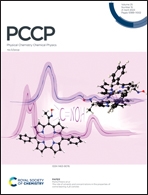A family of robust Dirac cone materials: two-dimensional hexagonal M3X2 (M = Zn/Cd/Hg, X = Si/Ge)†
Abstract
The fascinating Dirac cone, which has produced some excellent properties in graphene, such as ballistic charge transport, ultra-high carrier mobility and the quantum Hall effect, has motivated researchers to design and study more two dimensional (2D) Dirac materials. In this work, we have designed a family of 2D Dirac cone materials M3X2 (M = Zn/Cd/Hg, X = Si/Ge) and studied their superior properties by first principles calculation. The calculated cohesive energy, phonon dispersion and ab initio molecular dynamics confirmed the energetic, dynamic and thermodynamic stability of Zn3Ge2, Cd3Ge2, Hg3Si2, and Cd3Si2 monolayers. It was found that the intrinsic Dirac cones exist in the electronic structure of the Zn3Ge2, Cd3Ge2, Hg3Si2 and Cd3Si2 monolayers. Their Fermi velocities are from 3.26 × 105 m s−1 to 4.32 × 105 m s−1 (8.2 × 105 m s−1 for graphene). It is noteworthy that the Dirac cone in the M3X2 structure is robust. It is independent of external strain (from −7% to +19%) and can also be preserved as one-dimensional zigzag nanoribbons and multilayers (from two to three-layers). Our work shows that the novel M3X2 Dirac cone materials are an important candidate for high-speed nanoelectronic devices.



 Please wait while we load your content...
Please wait while we load your content...